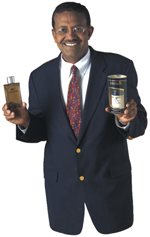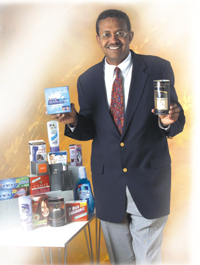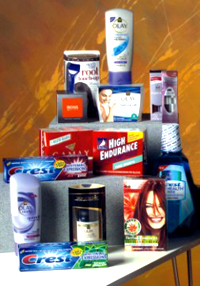| |
 |
The Great White Hope
|
He can make your wrinkles disappear without ever wielding the scalpel. If your teeth are a shade of yellow that will shame turmeric, he's your great white hope. And if he decides that your market has the potential, a few hundred million dollars in investment could easily change banks. As vice-president, (R&D), global personal beauty care and hair colourants, at the $55 billion Procter and Gamble, Shekhar Mitra has the power to do all that and more.
|
By Rakesh K. Simha
|
| |
|
| |
|
| As a global leader with a planet-girdling multinational, Mitra's job is to understand the needs of people worldwide, whether it is oral, health or beauty care. An accomplished chemist who grew up in Kolkata and studied at IIT, Columbia and Yale, Mitra manages a key outpost of the P&G empire, the Health Care Research Centre in Mason. He is in charge of two other such centres in the UK and Beijing . The 50-year old executive, who wears gold-rimmed glasses, says he left academia because he believed in P&G's stated mission to improve the lives of the world's consumers. He didn't regret his decision.
With one of the best R&D teams in the world, Mitra got down and dental. One of the key products that came spinning out of P&G's skunk works under his supervision was Crest Whitestrips. The effort to un-stain American teeth started in Mason at the company's largest technological centre. |
 |
|
P&G saw early that the fastest way to the consumer's wallet was through his oral cavity. But more than the millions of dollars in R&D funding and the mixing of chemicals by the gallon, Crest Whitestrips was the result some out-of-the-box thinking. |
 |
Back in the eighties when taking your teeth to the cleaners—or call them dentists if you will—cost as much as $750 dollars and required oodles of will power just to haul yourself to his office, the P&G A-Team decided that to take this line mass market, they had to come down several notches on the price ladder. Also, they had to conjure up a product that could be used regularly at home and was unobtrusive. The result was spectacular. Even at $40 a pop, Whitestrips where flying off the supermarket shelves. In 2001, it posted $23 million in Internet and dental office sales before it even hit store shelves.
And sales hit $200 million in the first year of the national rollout, making Crest become P&G's newest billion-dollar brand.
Mitra's is a success story mainly because he has embraced the P&G philosophy. “We don't sell snake oil in a bottle,” he asserts. It's this commitment to give the consumer only the best product that his money can buy that has made P&G a global MNC from a candle making company over 100 years ago. |
|
| |
|
Mitra can claim some credit for reinforcing the P&G ethos. Back in the early eighties, P&G was looking at the then promising Chinese market. The product it was planning to launch was its Crest toothpaste. But Mitra, who was a director in the company's China operations said that there was no way the company could hope to sell in that country at $1.87 a tube. They had to sell at a lower, much lower, price. At the same time, there would be no pushing a watered down product; it had to be as good as the Crest that was sold in America . “I wanted to create a toothpaste with superior benefits at a price that was one third the cost of the North American price,” he says. The P&G research teams got down to brass tacks and as usual delivered what was expected of them. The upshot: Crest
|
| |
|
became a runaway hit in Chinese bathrooms while a rival multinational that launched a stripped down “Third World” product got creamed. As one of the first Asians to rise to the top in P&G, Mitra knows that it's the company's policy to snap up the best talent in the world that keeps its nose in front. “Without the diversity in the workplace how can you understand the world markets,” he says. He likes to point out the fact that of the 10,000 employees in its R&D team, as many as 1,200 are PhDs.
It's this appetite for talent that has brought the company to India . In August 2004, P&G entered into a tieup with India 's Council of Scientific and Industrial Research. CSIR is India 's largest network of government research laboratories and has 38 laboratories across the country and over 6,000 scientists working in fields like chemistry, space, pharma, physics and botanicals.
Mitra was one of the leaders of the top team that signed the “strategic” pact with CSIR. P&G believes India 's intellectual capital, technical and scientific expertise, and its world class centres of excellence create a unique opportunity for the company to accelerate its innovation capability. |
 |
|
So how does it benefit both organisations? “P&G's core competency lies in chemistry and biochemistry while CSIR excels in several areas, and they have huge technology platforms,” he says. So while CSIR has developed technologies, they can't really take them to market. And P&G doesn't want to re-invent the wheel. In that sense it looks like a happy marriage. P&G looks at technologies that can be spun around to serve unmet consumer needs, and the Indian labcoats get their toil's worth. “If we can combine our skills with the problem-solving abilities of top notch scientists and engineers, it will be a perfect match,” he says.
While Mitra doesn't give any figures, the operation could be a major one. CSIR has 38 labs across India and P&G can pick and choose the labs it wants.
P&G is also setting up a connect-and-develop hub in Bangalore . The company will invest initially and hire people to help it coordinate and run some programs in CSIR labs. P&G will determine which areas are top priority. The programs will have to be managed by scientists and engineers in Bangalore . They will coordinate with engineers and scientists at the company's Cincinnati headquarters.
So what kind of workplace can Indians expect at P&G? There is no discrimination in the workplace, Mitra asserts. “If you hire the best talent and they are delivering, there is no discrimination,” he says. “We are tapping into the best minds and India is a huge supplier of talent. When I joined I was one of the first Asians. Now there are so many.”
Mitra gives a peek into how P&G takes on its rivals in the US and worldwide without the war cries and noise that one sees, for instance, in the Coke and Pepsi bust-ups. The company goes about its business in a, well, business-like way. Take the development of Olay skin regenerating cream. The company first interviewed hundreds of women and discovered that contrary to popular belief women didn't like the invasive nature of cosmetic change. So the company came up with amino-peptides that help the skin regenerate.
Despite the army of scientists, worldwide tieups and an expansive product portfolio, has gone in for old-fashioned takeovers to achieve turbo growth. A few weeks back it completed the takeover of Wella of Germany, which boosts its presence in hair colourants. Mitra says the alliance complements P&G in the professional segment.
But more than the buyouts and the tieups, it will be the company's internal strength that will keep its passel of product stacked high on supermarket shelves. As Mitra puts it, “Innovation is the lifeblood of our business. My role is to keep P&G in that role.”
Right now India is on the P&G map perhaps where China was 20 years ago. Fabric care and home care products—Ariel, Tide—are the priority areas for India , says Mitra. For those of you who want to whiten their tea- or paan-stained teeth, our advice is: wait a little longer.
Box: Mitra knows it's the company's policy to snap up the best talent in the world that keeps P&G's nose in front |
| |
|
|
|
|
|
|
|